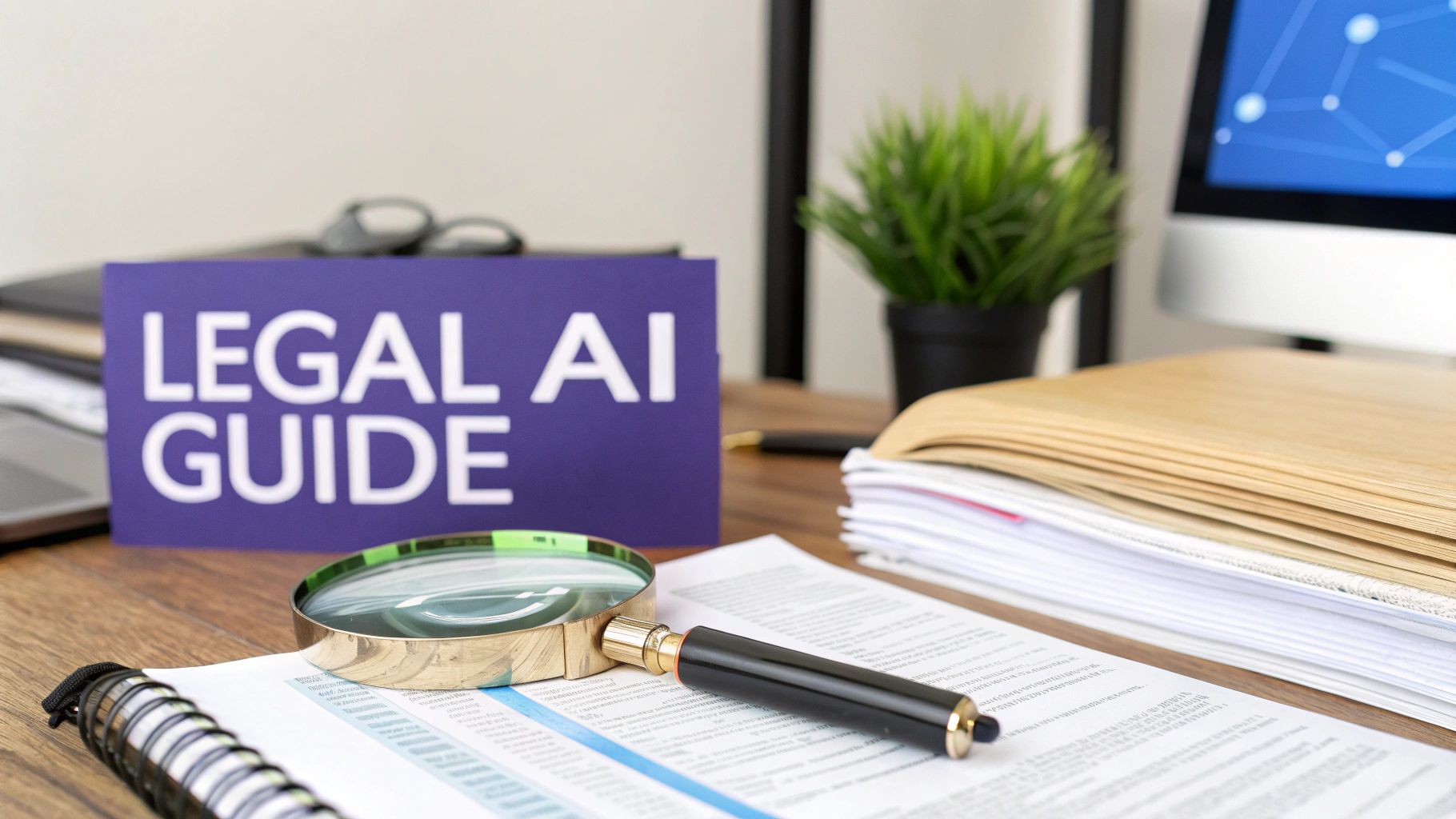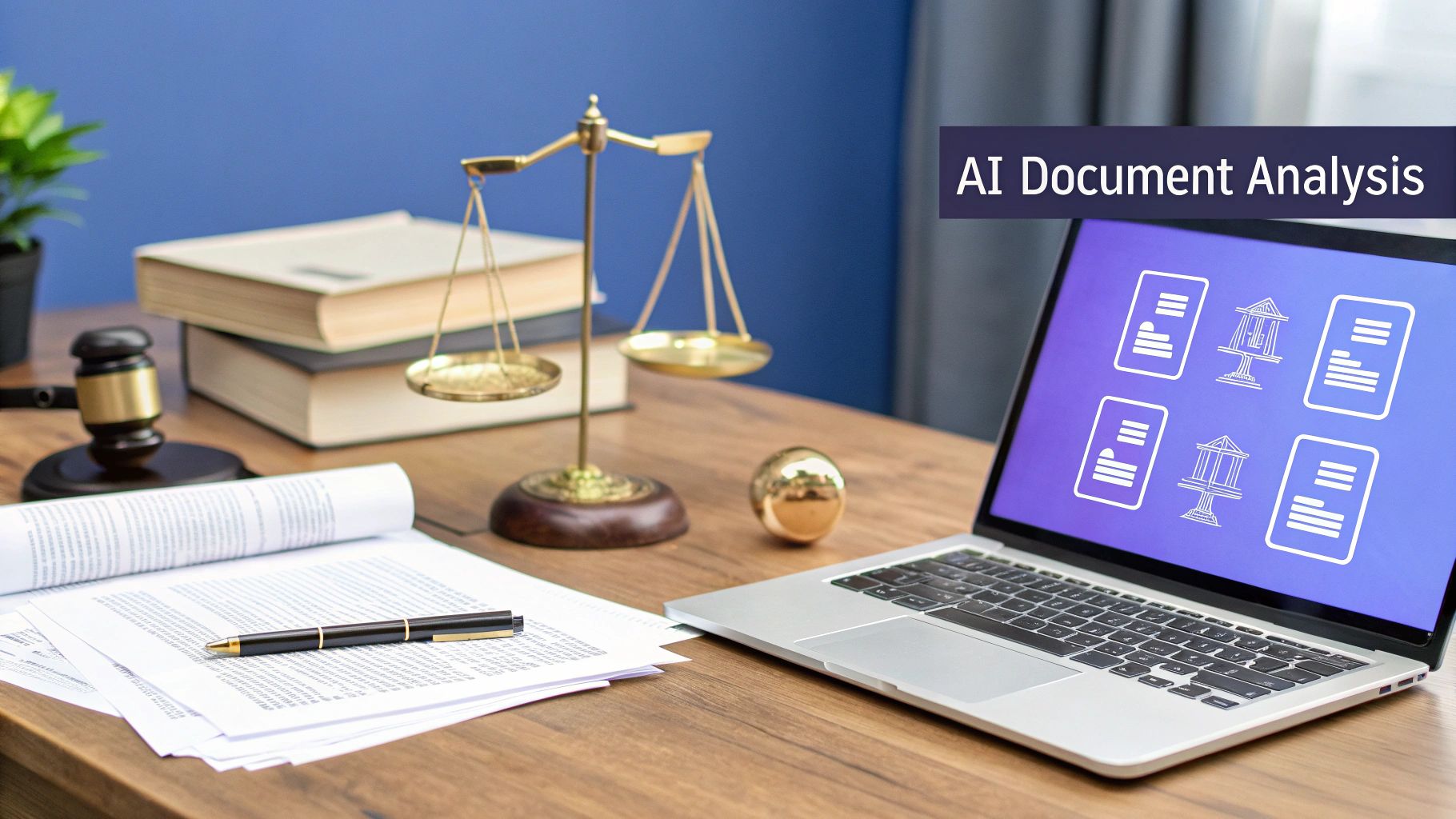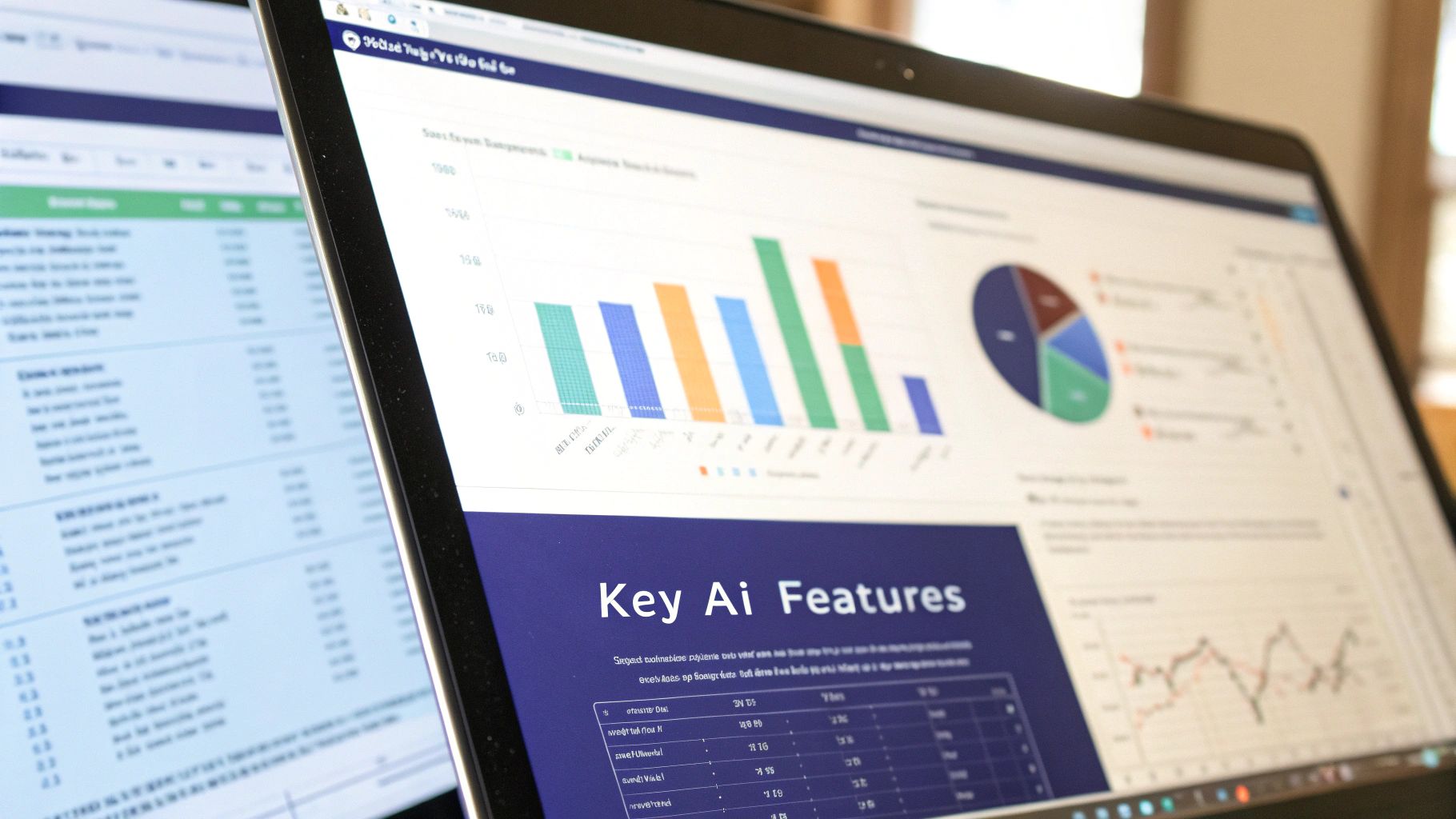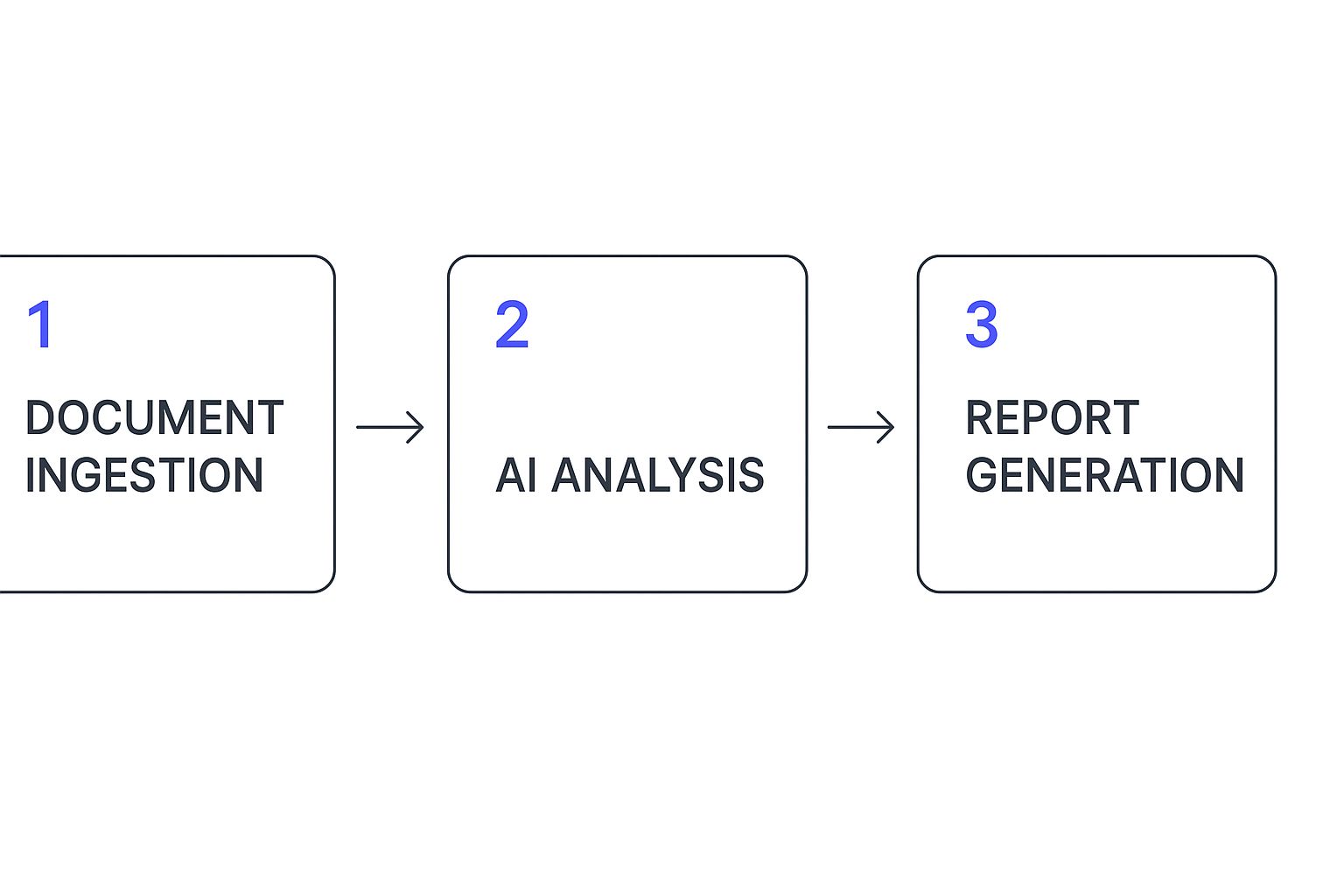
Understanding AI Legal Document Analysis Beyond The Hype

Imagine trying to find a specific grain of sand on a beach. That's what reviewing mountains of legal documents can feel like. This is where AI legal document analysis steps in. Think of it as your super-efficient research assistant, capable of processing huge amounts of information incredibly fast. This technology is changing how legal professionals operate, offering major boosts to efficiency and accuracy. But it's important to understand exactly what it can and cannot do.
This isn't about replacing lawyers; it's about empowering them. AI legal document analysis enhances human skills, not replaces them. It's like giving a legal professional a high-powered microscope. For example, AI can quickly pinpoint unusual clauses hidden within hundreds of contracts, alerting lawyers to potential risks they might otherwise overlook.
AI also excels at comparing different versions of a document. It can easily highlight small changes that could have big legal implications. This frees up lawyers to focus on strategy and important decisions, instead of getting bogged down in manual review.
This shift towards AI-powered tools is clear in the market’s growth. The legal AI market, which includes document analysis, has seen a major uptick in recent years. In 2024, the global legal AI market was valued at about USD 1.45 billion. It's projected to reach USD 3.90 billion by 2030, growing at a compound annual growth rate (CAGR) of 17.3% between 2025 and 2030. Discover more insights
From Hype to Reality: Practical Applications of AI
AI is changing key parts of legal work. One major area is due diligence. AI can analyze thousands of pages of documents, identifying vital information for mergers, acquisitions, or investments. This dramatically speeds up the process and reduces human error.
Another important application is contract management. AI can automatically pull out key terms, keep track of deadlines, and monitor compliance across many agreements. This organized approach lowers risks and helps ensure everyone sticks to the contract's rules.
Finally, AI is useful in litigation. It can analyze discovery documents, finding relevant evidence and highlighting important patterns that could be crucial for building a strong case.
AI legal document analysis isn’t some far-off technology; it’s being used today to reshape the legal field. By understanding its real strengths and limitations, legal professionals can use this powerful tool to improve their practice and provide better service to their clients. It’s about understanding the practical uses, not just the hype.
What AI Actually Delivers For Legal Document Work
Let's cut through the hype. Imagine AI as your super-powered research assistant, tirelessly sifting through legal documents and spotting key details. This isn't science fiction; it's the reality of AI legal document analysis. In this guide, we'll explore how these tools actually work and the real benefits they offer.
Key Capabilities of AI in Legal Document Analysis
AI legal document analysis provides some truly valuable capabilities that change the way legal work gets done:
Automated Clause Extraction: Imagine needing to find a specific clause buried within hundreds of contracts. Manually, this would be a huge undertaking. AI can pinpoint and extract those clauses, even if they're written in different ways, across a mountain of documents in a fraction of the time. This lets lawyers quickly compare clauses, ensuring they're consistent and spotting any potential conflicts.
Risk Identification and Alerts: AI is like a tireless watchdog, alerting you to hidden dangers in your legal documents. It can highlight unfavorable terms, missing information, or sections that clash with regulations. This proactive approach minimizes risk and prevents expensive legal battles down the road.
Document Comparison and Version Control: Ever struggled to keep track of different versions of a document? AI simplifies this by automatically comparing versions and highlighting any changes, additions, or deletions. This ensures everyone's working from the most current version and reduces errors caused by using outdated information.
To illustrate these capabilities more clearly, let's dive into a comparison of how AI performs across different types of legal documents.
To better understand these capabilities, the table below shows a practical comparison across various document types:
| Document Type | AI Capability | Accuracy Level | Time Savings | Human Oversight Required |
|---|---|---|---|---|
| Contracts | Clause Extraction | High (90-95%) | Significant (70-80%) | Moderate |
| Lease Agreements | Risk Identification | Medium (80-85%) | Moderate (50-60%) | Moderate |
| M&A Due Diligence Documents | Document Comparison | High (95-98%) | Significant (80-90%) | High |
| Litigation Discovery Documents | Key Information Extraction | Medium (75-80%) | Moderate (60-70%) | High |
This table demonstrates the potential of AI across different legal tasks. While accuracy and time savings are impressive, it's crucial to remember that human oversight remains important, especially for complex legal matters.
Real-World Examples: AI in Action
Let's explore how AI is making a difference in real legal scenarios:
Real Estate: Imagine a legal team reviewing hundreds of lease agreements. AI can swiftly extract key details like lease duration, rent escalations, and termination options. This information can be compiled into a usable format, making it easy to analyze trends, compare terms, and make informed decisions.
Mergers and Acquisitions (M&A): During due diligence, AI can quickly analyze thousands of documents, pinpointing critical information about financial obligations, intellectual property, and regulatory compliance. This accelerates the entire process, allowing deals to close faster.
Litigation: AI can analyze discovery documents, finding relevant evidence and highlighting key patterns that could be crucial to a case. This frees up lawyers from countless hours of manual review, allowing them to focus on building their legal strategy.
These examples showcase how AI is changing the legal field, increasing efficiency, improving accuracy, and reducing costs.
Understanding AI's Limitations in Legal Document Analysis
While AI offers significant advantages, it's important to be realistic about its limitations. AI algorithms learn from existing data. This means they can struggle with novel legal issues or situations not found in their training data.
This highlights the essential role of human oversight and legal expertise. AI is a powerful tool, but it can't replace the critical thinking and strategic decision-making of a skilled legal professional. Understanding these limitations ensures realistic expectations and successful use of AI in legal practice. AI and human legal expertise complement each other, creating a powerful combination.
How Legal Teams Are Using AI Document Analysis Today

Let's shift gears from theory to practice and explore how legal teams are using AI document analysis in the real world. This technology is changing the game, from small firms to large corporations. We're talking tangible, measurable advantages, not just futuristic fantasies.
Streamlining Contract Review with AI
One of the most common applications of AI legal document analysis is contract review. Think of a mid-sized firm constantly dealing with vendor agreements. Manually reviewing every single contract is a slow, error-prone process. AI can automate much of this.
For example, AI can quickly pinpoint key clauses, flag potential risks, and even compare different contract versions. This significantly cuts down review time, allowing lawyers to focus on more strategic work. One firm reported a 75% reduction in contract review time after adopting AI, freeing up valuable time for client interactions and case strategy.
Standardizing Legal Language Across Global Operations
For in-house legal teams at multinational companies, keeping legal language consistent across global operations is a major headache. AI can help by analyzing contracts and other legal documents to find variations in wording and phrasing.
This means an in-house team can ensure standardized language, minimizing legal risks and improving clarity across all operations. AI also assists with translation and interpretation, allowing global teams to collaborate more effectively.
Monitoring Regulatory Changes with AI
Staying up-to-date with ever-changing regulations is a big concern for compliance officers. AI can monitor these changes across entire document libraries, alerting legal teams to potential compliance problems.
This proactive approach reduces risk and helps organizations stay ahead of the game. Plus, it offers peace of mind knowing that a tireless digital helper is constantly on the lookout for potential issues. The North American generative AI in legal market, including document review, is booming. In 2024, the U.S. market was valued at around USD 20.5 million and is projected to reach USD 38.9 million in 2025. Document review itself held over a 37.5% market share in 2024. Find out more about generative AI in the legal field. This growth demonstrates the increasing importance of AI document analysis for legal teams.
Implementation Challenges and Unexpected Benefits
While AI offers clear benefits, putting it into practice does come with its own set of challenges. One key hurdle is integrating AI into current workflows. Legal teams need to think carefully about how AI will fit into existing processes and how best to train team members on the new tools.
However, many firms report unexpected positives, such as improved team collaboration and greater job satisfaction. By automating tedious tasks, AI lets legal professionals focus on more engaging and intellectually stimulating work. These real-world examples offer valuable insights for organizations considering AI document analysis. They highlight the practical value, the potential roadblocks, and the surprising ways AI can improve legal work.
Building AI Into Your Legal Practice Workflows
Moving from theory to practice with AI legal document analysis involves understanding how this tech improves your current systems. It's not a replacement, but an enhancement. Think of it like adding a GPS to your car – you still drive, but with better navigation.

This infographic shows the basic workflow: Document Ingestion (uploading your documents), AI Analysis (algorithms extracting information and identifying risks), and Report Generation (actionable insights). This process cuts down manual review time and boosts accuracy.
Implementing AI Step-by-Step
Successful implementation involves a few key steps:
Identify Key Use Cases: Begin by pinpointing areas where AI will be most beneficial. Focus on tedious tasks or those prone to human error, like contract review or due diligence.
Select the Right Tools: Choose AI tools suited to your needs and document types. Consider factors like accuracy, integration capabilities, and security.
Data Preparation and Ingestion: Organize your documents and ensure they're in a compatible format. This might involve converting files or adding metadata tags.
Team Training and Onboarding: Train your team on using the AI tools and interpreting results. Make sure everyone feels comfortable using the technology.
Establish Quality Control Protocols: Set up checks to ensure the AI's output is accurate. This might involve human review or automated validation.
You might be interested in: Learn more in our article about legal workflow automation
This Wikipedia screenshot highlights tech's growing role in law:

The image shows different legal tech aspects, emphasizing how vital technology is becoming to modern legal practice. Smart planning and execution are key for successful integration.
Managing the Human Side of AI Implementation
Implementing AI means managing the human element, too. Address any concerns your team might have about job security. Emphasize that AI helps boost their skills, not replace them.
Getting everyone on board is crucial. Clearly explain the benefits of AI and address any resistance. Building trust in the tech will lead to smoother integration. By addressing both the technical and human sides, you can integrate AI legal document analysis effectively.
Choosing The Right AI Legal Document Analysis Tools
The market for AI legal document analysis tools is flourishing. Many platforms offer exciting possibilities for improving legal work. But finding the right tool isn't about grabbing the shiniest option. It's about finding the one that truly fits your needs. This section will help you understand the world of AI legal document analysis tools and empower you to choose wisely.
Key Evaluation Criteria
Think of choosing an AI tool like buying a new car. You wouldn't buy a sports car if you needed a minivan for your family. Similarly, different legal practices have different needs. Consider these factors:
Document Type Support: Does the tool handle the kinds of documents you use every day? A tool great for contracts might not be ideal for analyzing court transcripts.
Accuracy and Speed: You need both. Speed is tempting, but accuracy is paramount. Imagine a fast car that can't brake! Some tools prioritize speed, others accuracy – find the right balance for you.
Integration Capabilities: Can the tool work smoothly with your existing systems? Seamless integration is like having a key that opens all the doors in your office – smooth and efficient.
Security and Privacy: Protecting client data is non-negotiable. Make sure the tool prioritizes security and follows data privacy rules.
User Experience: Is the tool easy to use? A user-friendly interface is like a car with intuitive controls – it makes the ride much smoother.
Training Data: What kind of data was the AI trained on? This shapes its “understanding.” A tool trained on general legal texts might struggle with specialized areas like patent law.
Asking the Right Questions
Don’t hesitate to ask vendors tough questions. It’s like test-driving a car before you buy it:
Can you share success stories from similar firms? Seeing how others have benefited is like getting a recommendation from a trusted friend.
What are the tool’s limitations? Every tool has them. Understanding what a tool can’t do is as important as knowing what it can do.
What kind of support and training do you provide? Good support is like having a reliable mechanic on call.
How does the tool handle legal updates and changes? Laws change. Your tool needs to keep up.
What’s the pricing structure? Understand all costs upfront, including any hidden fees.
The demand for AI in legal document drafting and review is exploding. Revenues in 2024 reached USD 206.4 million and are expected to hit USD 549.5 million by 2030. Explore more insights on the growth of legal AI in document analysis. This growth demonstrates the real potential of AI in this area. For more information, see our guide on: AI for legal documents.
Red Flags to Watch For
Look out for these warning signs:
Overblown promises: If it sounds too good to be true, it probably is.
Lack of transparency: Vendors should be open about their AI’s training and limitations.
Poor user reviews: Check online forums and reviews for honest feedback.
Resistance to customization: The tool should adapt to your workflow, not the other way around.
Limited integration options: Integration problems can disrupt your existing processes.
Choosing the right AI tool is an investment in your firm's future. By considering these points and asking the right questions, you can select a tool that truly meets your needs and delivers a solid return on investment.
To help you compare different platforms, we've compiled a table highlighting key features, document types supported, integration options, pricing, and ideal use cases.
To help you navigate the many choices, here's a comparison table:
AI Legal Document Analysis Platform Comparison: This table compares leading AI legal document analysis platforms, including their pricing, features, and integrations.
| Platform | Key Features | Document Types | Integration Options | Pricing Model | Best For |
|---|---|---|---|---|---|
| Kira Systems | Term extraction, clause identification, due diligence | Contracts, agreements, leases | Salesforce, NetDocuments | Subscription | Large law firms, corporations |
| Logikcull | E-discovery, automated redaction, data analysis | Legal documents, emails, images | Slack, Dropbox | Subscription | Litigation, investigations |
| Lex Machina | Legal analytics, litigation prediction, judge profiling | Court documents, filings | LexisNexis | Subscription | Litigation strategy |
| ROSS Intelligence | Legal research, case law analysis | Case law, statutes | Westlaw | Subscription | Legal research |
| Legal Document Simplifier | Jargon simplification, key point extraction, risk alerts | Contracts, agreements | API | Subscription | Small businesses, individuals |
This table provides a quick snapshot of some popular platforms. Keep in mind that features and pricing can change, so always consult the vendor’s website for the most up-to-date information. Your best choice depends on your specific needs and budget.
By carefully evaluating your options and asking the right questions, you can select an AI legal document analysis tool that boosts your firm's efficiency and helps you achieve your goals. Choose wisely, and you'll be using AI effectively – not just buying into the hype.
Ensuring Quality And Professional Standards With AI

AI legal document analysis has amazing potential. However, responsible use is paramount. Think of AI as a high-performance car – it needs a skilled driver to navigate effectively. Maintaining professional standards requires diligent oversight and quality control. This section explores how legal teams can successfully integrate AI while adhering to ethical practices.
Structuring Human Oversight For AI-Driven Analysis
Effective oversight begins with clearly defined roles. Someone needs to lead the AI's training, evaluate its output, and make the ultimate decisions. This isn't about constantly monitoring the AI, but about providing expert guidance. It's similar to a senior lawyer mentoring a junior associate. The senior lawyer offers direction and ensures the work meets the firm's standards.
Establishing quality checkpoints is also essential. These checkpoints catch mistakes early on. For instance, a senior lawyer could review the AI's summary of key clauses before a contract is signed. More information on this topic can be found in our article on legal review of documents. This multi-layered approach combines efficiency and thoroughness.
Training Your AI For Specific Document Types
Like any new team member, AI needs proper training to be effective. Providing the AI with your specific document types and legal precedents improves its accuracy and relevance. This means the AI learns the specifics of your practice area and provides more focused results. It's like training a new employee – the more guidance you give, the better they perform.
Understanding the AI's limitations is also crucial. AI excels at repetitive tasks, but complex legal interpretation still demands human expertise. Knowing these limitations prevents over-reliance and promotes informed decisions. It's about using AI strategically, not blindly accepting its output.
Maintaining Audit Trails For Compliance
Detailed audit trails are vital for compliance and accountability. Tracking how AI was used, what decisions were made, and who made them promotes transparency. This is particularly important when explaining AI-assisted work to clients and courts. A clear record demonstrates your dedication to professional standards and ethical practices. It's like keeping detailed notes – you have a record of your process and choices.
Evaluating AI Recommendations and Providing Feedback
AI provides suggestions, not final answers. Legal professionals must carefully evaluate these suggestions within the context of each case. This means understanding the AI's reasoning and considering external factors. It's about using AI as a tool to enhance your judgment, not replace it.
Feedback loops that continually refine the AI's performance are equally important. When you disagree with an AI suggestion, explain why. This feedback helps improve the AI’s algorithms and its accuracy over time. It's like providing constructive feedback to a junior colleague – it helps them learn and grow. By implementing these strategies, legal teams can effectively use the power of AI while maintaining the highest professional standards.
Measuring Success And ROI From AI Legal Document Analysis
Justifying the cost of AI legal document analysis takes more than just talking about time saved. This section provides ways to measure success in a way that makes sense for a law firm's finances. We'll explore how to track important metrics, from accuracy improvements to how AI benefits the entire business.
Quantifying the Value of AI in Legal Work
Think of AI legal document analysis like buying a new piece of office equipment. You wouldn’t just assume it's working; you'd track its performance. Measuring the return on investment (ROI) of AI is similar. It involves watching key metrics. This includes quantitative measures, like processing time and cost per document, and qualitative benefits, like improved consistency and better risk identification.
Quantitative metrics give you hard numbers. For example, you can measure how much faster contracts are reviewed with AI than by hand. You can also track the cost of analyzing each document, showing how much money you save. This data gives you a clear idea of how much more efficient your work is.
Qualitative benefits are trickier to measure but just as important. AI helps make your work more consistent by using the same standards for every document. This minimizes differences and makes your legal position stronger. Finding risks earlier is another qualitative benefit, preventing expensive legal problems later on.
Demonstrating Value to Stakeholders
Showing partners and stakeholders the value of AI requires a clear and interesting explanation. This means showing both the quantitative and qualitative benefits. Imagine showing partners a report that demonstrates a 60% reduction in due diligence time and a 20% drop in legal review costs. These numbers are powerful.
Also, highlight how AI strategically improves your business. For example, processing contracts faster means closing deals faster, which leads to getting paid faster. Better compliance lowers legal risk and protects the firm's reputation. These real-world benefits show the true value of AI legal document analysis.
Practical Templates and Tracking Tools
To effectively measure success, use simple tools. Set up a spreadsheet to track things like processing time, cost per document, and error rates. Regularly check these numbers and compare them to how things were before using AI.
Create regular reports to share progress with firm leadership. These reports should summarize key metrics, highlight successes, and outline plans for making things even better. Regular reporting keeps everyone in the loop and helps make decisions based on the data.
Case Studies: Quantifying AI Success in Legal Practices
Real-world examples offer strong proof of AI's value. Imagine a case study explaining how a law firm sped up contract review time by 70%, allowing lawyers to handle more cases without hiring more people. Or a story about how AI found an important clause hidden in a complicated merger agreement, preventing a potentially disastrous legal fight.
These stories resonate with legal professionals and demonstrate the practical benefits of AI. They offer real proof of success and build confidence in what the technology can do. By measuring AI’s impact thoroughly, legal teams can effectively show its ROI, justify continued investment, and fine-tune its use for even better results.
Ready to make your legal documents easier to manage and discover useful information? Visit Legal Document Simplifier today to learn more and start your free trial.